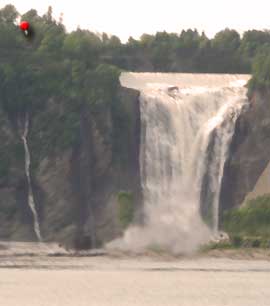Marriage.

l'Île-d'Orléans.
When Barbe Menard arrived as a Fille du roi she was set up in a sponsor's home who then served as chaperone when Antoine and Barbe were introduced to one another. Unlike the custom in France, Barbe would have a say in who she married. The wedding date was set for 26 August 1669 in Sainte-Famille. The couple became neighbors of our ancestor Nicolas Patenaude.
The parish had been established eight years earlier on an island on the Fleuve Saint-Laurent called l'Île-d'Orléans. An abundance of wild grapes growing there prompted Cartier to name the island Bacchus at first. The island was blessed with rich farm land and a view of the beautiful Chute Montmorency tumbling into the river.
The couple had eight children in their sixteen years of marriage. After the first child was born, he aquired a cow from Marie-Barbe de Boulogne. In the 1681 census Antoine, 45 and Barbe 32, are found with four of their children: Marie, 8, Marguerite, 6, Antoine, 3 and our ancestor, Jacques, 3 months. The older children were likely working under contract as there is evidence that Marie-Anne, age 14 in 1684 and later, Marguerite age 13 in 1688 were contracted out. Under these arrangements, the children worked for the contract owner and in return were housed and received food and some clothes.
Farming on the Frontier.
The habitants grew enough food for their family, and a bit more to sell in town. They hunted and fished which afforded them a much better diet than was available in Europe. The snow and ice that accrued during long cold winters provided a natural deep freezer to store the game, fish and eels they caught. When the Saint-Laurent froze over in the winter residents of l'Île-d'Orléans drove their sledges across the ice to get to the mainland. In ville de Québec markets the frozen meats would be cut with a saw for sale. A mild winter in some ways could spell disaster if it threatened their food storage ability.
Barbe's Passing.
Barbe gave birth to twins on 16 June 1685, but she, and one of the babies, did not survive. They were buried the next day from Sainte-Famille (the survivor was Jean). Childbirth was very dangerous in the frontier and many women succumbed to various complications. Our ancestor, Jacques, was just four years old.
According to at least one compiled source (Tanguay) Antoine married again, but the actual record of his marriage to Marie-Anne Boisseau was not found. According to Tanguay the youngest child, another Jean, was Marie-Anne's child born 17 June 1687, but likewise this birth record was not found. The information seems to stem from a Ville-Marie marriage record which names Marie-Anne as mother of the groom, Jean Vermet.
On 13 June 1707 Antoine agreed to a donation à cause de mort with Joseph-Antoine Dufresne Sieur de LaPipardière. This action was usually taken to insure an elderly person's care. Antoine was in his 70's when he passed sometime between 1708 and 1713. (His name was not found on a 1709 map.) Records indicate he was interred on the island.
- Montmorency Falls by Cynthia Petelle
- Jetté, René, Dictionnaire généalogique des familles du Quebec des origines à 1730 (Montréal: Les Presses de l'Université de Montréal, 1983
- Tanguay, L'Abbé Cyprien, Dictionnaire généalogique des familles Canadiennes depuis la Fondation de la Colonie Jusqu'a Nos Jours (Baltimore: Genealogical Publishing Company, 1967)
- Notre-Dame-de-Québec, Québec, Canada, FHL Film #1289658
- Ville Marie Basilique Notre-Dame, 1713 (copie textuelle) In Jette this Jean Vermet's marriage, and Antoine, his father is still alive but his mother is listed as Marie-Anne Boisseau. Tanguay assumes Antoine's second marriage from this entry. Online indexing indicates this is the Vermuil family
